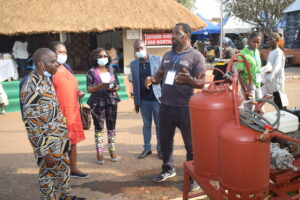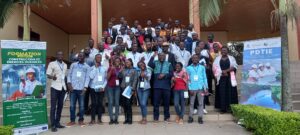Lionelle Ngo-Samnick is an agro-economist and programme specialist at the Institut de la Francophonie pour le développement durable – IFDD. She has more than 20 years of experience in managing sustainable development programmes in over 30 countries. For the past two years, she has been managing the PDTIE project (Deployment of Environmental Technologies and Innovations for Sustainable Development and Poverty Reduction), led by IFDD in the Democratic Republic of Congo and Cameroon, in partnership with Kongo University in the DRC, Eden Africa and Ingénieurs Sans Frontières in Cameroon. She talks about women and girls in science on their international day.
While STEM skills are among the most sought-after and can have an impact on all dimensions of society, women represent only 28% of engineering graduates and 40% of computer science graduates. In areas such as artificial intelligence, only 22% of professionals are female researchers. Ironically, these fields are experiencing a skills shortage. How do you view this situation?
If you look at the position of women and science a few decades ago, the evolution is rather positive. But the work is not finished and one of the first difficulties to be overcome is the glass ceiling. At the undergraduate and graduate levels, women are present in significant numbers, but as soon as you reach the doctoral level, there is a dramatic drop in their representation.
To what main reasons do you attribute this situation?
I don’t have any studies to back up my perception, but I think that the weight of family responsibilities plays a huge role. At the undergraduate level, women have not yet taken on family responsibilities, and they are often very committed to their studies. But as soon as they reach the age where they get married and start families, their numbers drop and I think that there is certainly a correlation between their family life and the decline in their commitment, both in studies and in the scientific fields.
You spoke of positive changes at the beginning of the interview. What other changes have you seen?
At the time, there was a tendency to steer women into jobs that were considered to be women’s jobs. Women were very afraid to go into the scientific fields, they were much more into the literary fields. And even when it was science, it was more soft sciences, life sciences. Things have changed a lot and when you look at the undergraduate level, parity has almost been achieved. Women are no longer afraid to do science, they are confident in their ability to carry out scientific studies. This is a positive result that is the fruit of several decades of hard work, advocacy, and female commitment.
How do you think the contribution of women scientists to sustainable development is different from that of men?
Women play a central role in community resilience strategies. They play a crucial role in the preservation of forest ecosystems, such as the Congo Basin, which contains 10% of the world’s biodiversity, or the use of natural resources for family food, which is much more supported by women in general. At the same time, they are the first victims of land degradation, which affects their production capacity. And with their children, they are more often the victims of natural disasters, such as floods, because they stay in the villages to support their families, while the men go to look for money in areas less vulnerable to climate change. Because of this experience, and their social responsibilities, particularly in terms of education, the transmission of knowledge, know-how and good practices, they bring a diversity of perspectives. In the framework of the PDTIE, which awards grants to young people to develop innovations, I noticed that the innovations carried out by women had a very close link with the resolution of everyday problems. Whereas men are often more inclined to work on improving processes, or basic science. I see two complementary ways of doing science.

(Exchanges with local innovators during the Cameroon International Handicraft Fair)
Let’s come back to the PDTIE. What concrete actions are you implementing in the framework of this project to obtain greater participation of women in your various actions?
The PDTIE has three areas of intervention that target young people, especially girls. In terms of education and training, we have online training, which is accessible to all. And face-to-face training, to accompany young people with a high potential in the application of knowledge. The third pillar is innovation, which IFDD supports. Despite our efforts to promote our online training, the result is not yet satisfactory, because out of the 36,000 young people trained, 26% were women. In terms of practical training, the difficulty is that since women have not taken the online training open to all, they are less likely to participate in the practical training. But the good news is that we have third-party projects that are also developing training. And there the representation of women is quite high because our partners are based in universities, in research centres, and they put in place incentives for their participation. Moreover, these training courses are often carried out during the first two university cycles when women are more present, and therefore they participate more in the training courses. Out of the forty or so training sessions organised within the framework of the PDTIE institutional mechanism, 1 269 young people were trained face-to-face, including 408 young girls, i.e. approximately 32% of the participants. Our partners in the field must select 50% of young innovators. As a result, out of the 52 innovations supported so far, 24 are by women. And they are high-quality projects. Medicines have been developed within the framework of the Centre for Research and Technological Innovation in the Environment and Health Sciences (CRITESS) project at the University of Kinshasa and we have also very good innovations in agri-food and sustainable construction. This clearly shows that when efforts are made, a new generation of researchers and innovators can emerge.

(Training in Yaoundé, Cameroon)
If we take a broader view of the research and innovation ecosystems, are there other actions that could be taken to involve them even more?
Yes, there are clearly efforts that should be made to ensure that women have access to research and leadership positions. Because when we look at the heads of scientific committees or research centres, for example, in some countries there are less than 5% of women in these positions and overall, we rarely reach the figure of 15%. I would also like to talk about the recognition of scientists. Barely 3% of Nobel Prize winners in the scientific fields are women. Another problem is the stereotyping of research topics. If these themes are not of interest to women, they are inevitably excluded from this research. The themes must therefore reflect the diversity of views. A final point, which I feel is important for the place of women in science, is working conditions: the pay scale, the terms and conditions, working hours, promotions, etc. We need more equity, flexibility and inclusion.
To conclude our conversation, what specific message would you like to send on the occasion of the International Day of Women and Girls in Science?
The situation of women scientists mirrors that of women in our society. The concentration of women in a limited number of scientific fields. Low presence of women in the highest-paid fields. Discrimination against women in the areas of scientific power… Equality between women and men in science is intimately linked to the sharing of knowledge, access to power and scientific recognition. We must learn from the lessons of the recent past but in part still present, notably the recent pandemic and the climate change that is absorbing us. We are all in the same boat. Our society cannot continue to deprive itself of all the creativity and talent of men and women. More than ever, a marked integration of women and girls in science is necessary to advance the science of tomorrow. A science that is even more inclusive, even more ethical, a science that takes care of humans and the planet.
